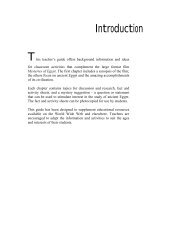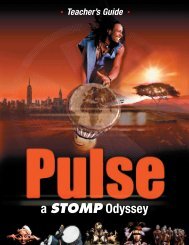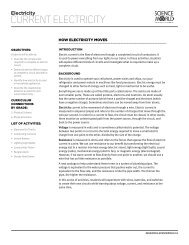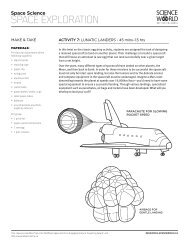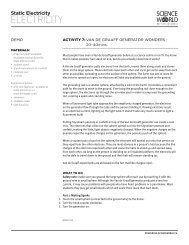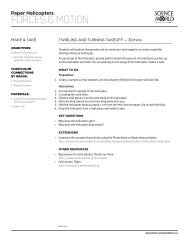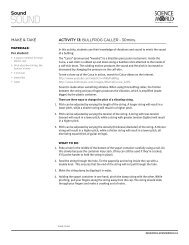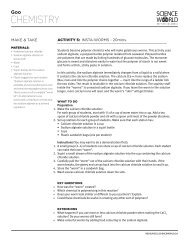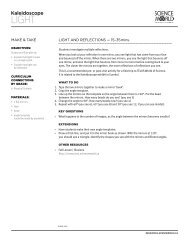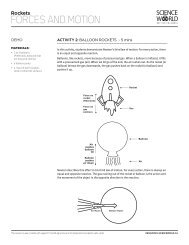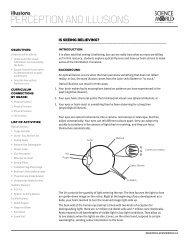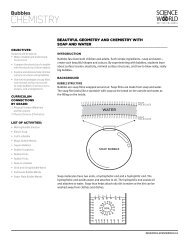Paper Plane Flying Contest - Science World Resources
Paper Plane Flying Contest - Science World Resources
Paper Plane Flying Contest - Science World Resources
Create successful ePaper yourself
Turn your PDF publications into a flip-book with our unique Google optimized e-Paper software.
Flight<br />
Forces and Motion<br />
ACTIVITY<br />
MATERIALS<br />
6-7 examples of paper airplane<br />
instructions downloaded from<br />
paper airplane making websites:<br />
http://www.10paperair<br />
planes.com<br />
http://www.funpaperair<br />
planes.com<br />
Per student:<br />
• 3 sheets of paper (preferably<br />
recycled or reused)<br />
• scissors<br />
• glue or tape<br />
• markers (for decoration)<br />
• paper clip (optional)<br />
ACTIVITY 8: PAPER PLANE FLYING CONTEST - 40mins<br />
What makes a paper airplane fly? Air. How easily a plane moves through the air, or its<br />
aerodynamics, is the first consideration in making a plane fly for a long distance. The<br />
next considerations are the four forces that act on an aircraft– drag, gravity, thrust<br />
and lift.<br />
<strong>Plane</strong>s that push a lot of air are said to have a lot of "drag," or resistance to moving<br />
through the air. If you want your plane to fly as far as possible, you need a plane with as<br />
little drag as possible.<br />
A second force that planes need to overcome is gravity. You need to keep your plane's<br />
weight to a minimum to help fight against gravity's pull to the ground.<br />
Thrust is the forward movement of the plane. The initial thrust comes from the muscles of<br />
the "pilot" as the paper airplane is launched. After this, paper planes are really gliders,<br />
converting altitude (height) to forward motion.<br />
Lift<br />
Drag<br />
Thrust<br />
Gravity<br />
Lift comes when the air below the plane wing is pushing up harder than the air above it<br />
is pushing down. It is this difference in pressure that enables the plane to fly. Pressure<br />
can be reduced on a wing's surface by making the air move over it more quickly. Curving<br />
the wings of a plane will enable air to move more quickly over the top of the wing,<br />
resulting in an upward push, or lift, on the wing. If the wing is too curved however, it will<br />
have either little effect or perhaps even the opposite effect.<br />
Long flights come when these four forces–drag, gravity, thrust, and lift–are balanced.<br />
Some airplanes, such as the Concord, are built to move extremely fast. These planes, like<br />
darts, do not have a lot of drag and lift: they depend on extra thrust to overcome gravity.<br />
<strong>Plane</strong>s that are built to spend a long time in the air, such as a Boeing 787, usually have a<br />
lot of lift but little thrust. These planes fly a slow and gentle flight.<br />
Activity 8 cont.<br />
RESOURCES.SCIENCEWORLD.CA
Flight<br />
Forces and Motion<br />
WHAT TO DO<br />
Instructions:<br />
Part 1:<br />
1. Print out various examples of paper airplane instructions and spread them out<br />
throughout the classroom as stations.<br />
2. Students walk around the room and hypothesize which one(s) will travel the furthest<br />
and/or have the fanciest flight (spins, loops, spirals).<br />
3. Their hypothesis should be based on what they have learned about the four forces<br />
of flight.<br />
Part 2:<br />
1. Hand out the material to the students.<br />
2. Each student is to design and build their own paper aircraft, keeping in mind the four<br />
forces affecting flight.<br />
3. Two awards will be given: 1) the furthest distance traveled; and 2) the fanciest flight<br />
(spins, loops, spirals etc.)<br />
4. Students are allowed to make up to 3 airplanes but only 1 can be entered into the<br />
contest. No other sheets of paper will be handed out.<br />
5. Allow 25 min for design and building and 15 min for testing.<br />
KEY QUESTIONS<br />
»»<br />
Why did some planes fly better than others?<br />
»»<br />
What helps a plane achieve the farthest distance?<br />
»»<br />
What can you change in an aircraft’s design to turn the plane left or right?<br />
EXTENSIONS<br />
»»<br />
Explain how you accounted for each of the four forces of flight while building your model.<br />
What would you do differently?<br />
»»<br />
How do rudders, elevators, and ailerons change the plane’s direction? How could you<br />
incorporate these into your design?<br />
NOTES<br />
RESOURCES.SCIENCEWORLD.CA



